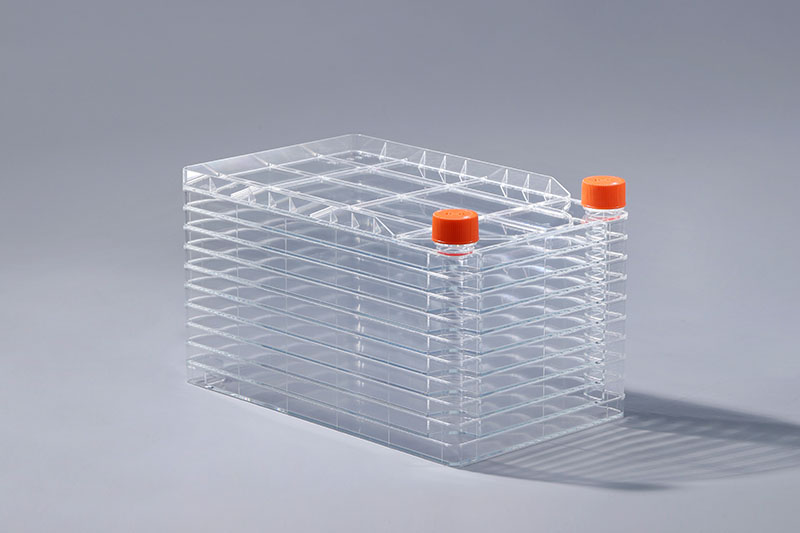Is cineál veicteora víreasach é lentivirus arna mhodhnú ó víreas easpa imdhíonachta daonna (VEID), ar cineál retrovirus é. I dturgnaimh in vitro agus i dturgnaimh in vivo, tá lentivirus anois ar cheann de na foirmeacha veicteoirí a úsáidtear go coitianta chun géinte exogenous nó shRNA exogenous a chur in iúl, agus tá sé á úsáid níos mó agus níos forleithne. Ina olltáirgeadh, is cultúr cille inchaite é the Cuirtear an mhonarcha cille i bhfeidhm go príomha ar tháirgeadh leathnaithe veicteoirí lentiviral. Féadann sé achar dromchla an chultúir cille a mhéadú, rud a mhéadaíonn toradh an veicteora, laghdaítear líon na n-amanna aistrithe agus athsholáthair mheán iar-aistrithe, agus costais saothair a laghdú. Is cultúr cille éifeachtach agus áisiúil é inchaite.. seichimh. I dtéarmaí ionfhabhtaithe, féadann sé cealla néarónacha, heipitocytes, cardiomyocytes, cealla meall, cealla endothelial, gaschealla agus cineálacha eile cealla a ionfhabhtú go héifeachtach, ionas go mbainfear amach éifeachtaí maith géinteiripe. I gcás roinnt cealla atá deacair a aistriú, mar shampla cealla príomhúla, gaschealla, cealla neamhdhifreáilte, etc., is féidir le húsáid veicteoirí lentiviral feabhas mór a chur ar éifeachtúlacht trasduchtúcháin an spriocghéine nó an spriocshRNA, agus is féidir leis an spriocghéine nó leis an spriocshRNA. a chomhtháthú isteach sa chill óstach. Méadaítear dóchúlacht an genome go mór, agus is féidir léiriú fadtéarmach agus cobhsaí an spriocghéine nó an spriocshRNA a bhaint amach ar bhealach níos áisiúla agus go tapa.
Chomh maith le bheith curtha i bhfeidhm ar tháirgeadh ar scála mór veicteoirí lentiviral, tá ról tábhachtach ag monarchana cille i dtáirgeadh ar scála mór teiripe cille, géinteiripe, teiripe víreas oncolytic. , agus vacsaíní.
The cell factory is mainly applied to the expanded production of lentiviral vectors. It can increase the surface area of cell culture, thereby increasing the yield of the vector, reducing the number of times of transfection and post-transfection medium replacement, and reducing labor costs. It is an efficient and convenient cell culture consumable.
In addition to being applied to the large-scale production of lentiviral vectors, cell factories play an important role in the large-scale production of cell therapy, gene therapy, oncolytic virus therapy, and vaccines.
The FAI climbed 5.9 percent year-on-year in the first 11 months of 2018, quickening from the 5.7-percent growth in Jan-Oct, the National Bureau of Statistics (NBS) said Friday in an online statement.
The key indicator of investment, dubbed a major growth driver, hit the bottom in August and has since started to rebound steadily.
In the face of emerging economic challenges home and abroad, China has stepped up efforts to stabilize investment, in particular rolling out measures to motivate private investors and channel funds into infrastructure.
Friday's data showed private investment, accounting for more than 60 percent of the total FAI, expanded by a brisk 8.7 percent.
NBS spokesperson Mao Shengyong said funds into weak economic links registered rapid increases as investment in environmental protection and agriculture jumped 42 percent and 12.5 percent respectively, much faster than the average.
In breakdown, investment in high-tech and equipment manufacturing remained vigorous with 16.1-percent and 11.6-percent increases respectively in the first 11 months. Infrastructure investment gained 3.7 percent, staying flat. Investment in property development rose 9.7 percent, also unchanged.
 English
English



















































